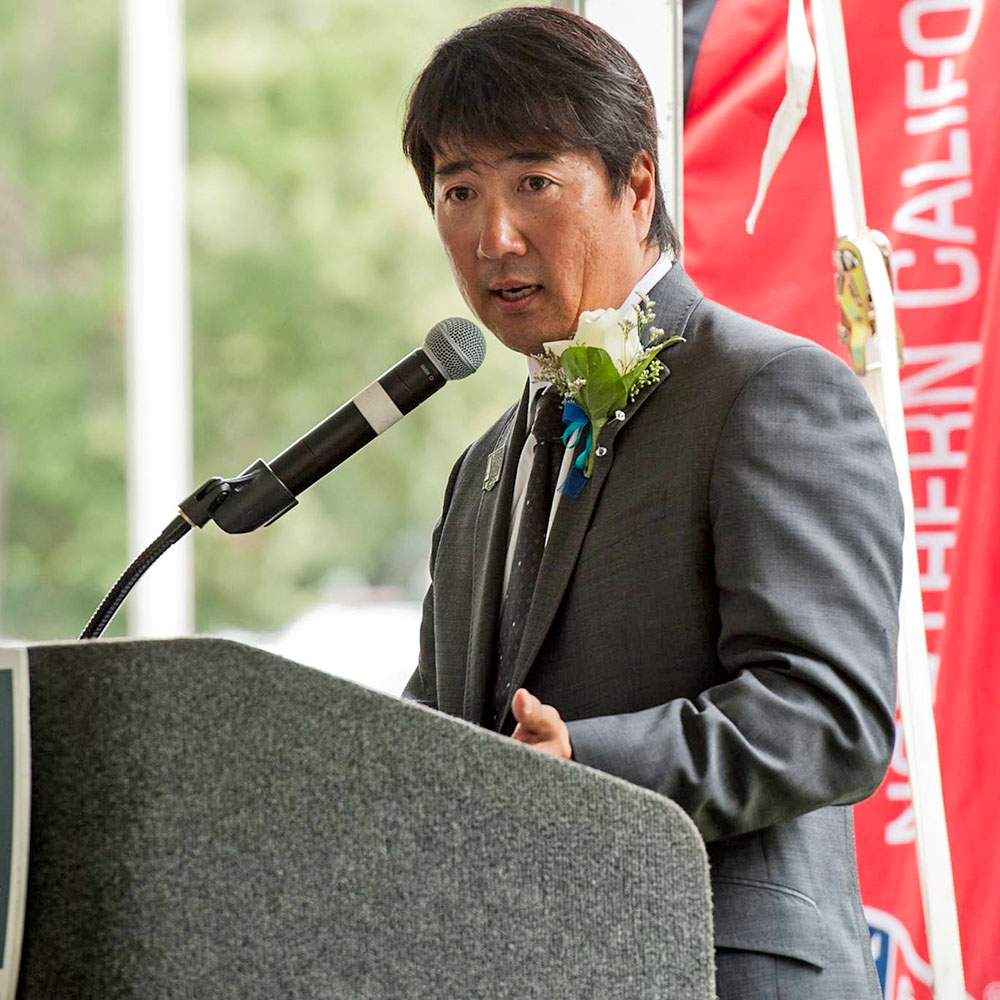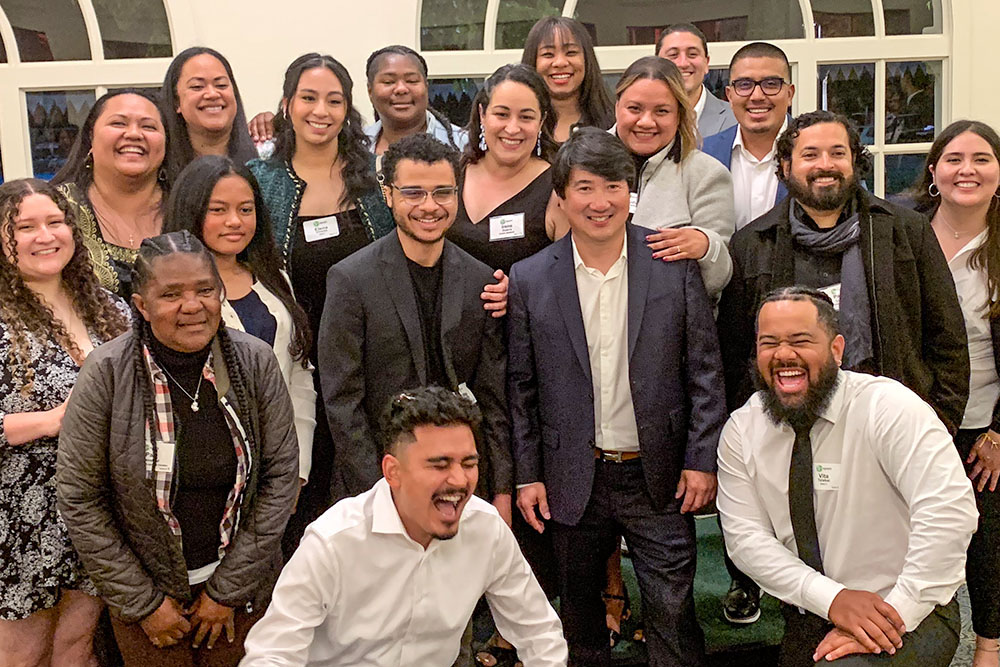DAVE HIGAKI IS A NATURAL, LIFELONG FIT
FOR NEW USTA FOUNDATION JOB
COMMUNITY TENNIS | USTA SOUTHERN CALIFORNIA
FOR NEW USTA FOUNDATION JOB
MAY 31, 2023 | JOEL DRUCKER

DAVE HIGAKI IS A NATURAL, LIFELONG FIT FOR NEW USTA FOUNDATION JOB
USTA SOUTHERN CALIFORNIA
MAY 31, 2023
JOEL DRUCKER



Top: Dave Higaki in a recent photo with student Luis; Middle: Dave Higaki speaking at his USTA Northern California Hall of Fame induction ceremony in 2017; Bottom: Dave Higaki with alumni of EPATT at an annual dinner.
SHARE THIS STORY
Do we choose our path or does our path choose us? Dave Higaki, now at the start of his new job in Los Angeles as national manager, participation, and capacity building for the USTA Foundation, addresses that question with the memory of a formative event that took place more than 40 years ago.
It happened in early adolescence. Higaki’s primary passion was sports. “Growing up,” he says, “I had a severe stutter. I was always a little bit more on the shy side. Sports became more of an outlet.”
One weekend afternoon, Higaki sat in his family’s Palo Alto living room and watched a game on TV with his father, Bob. Upon witnessing a great feat by one of the athletes, Dave turned to Bob and said: That guy’s the best guy in the world.
But life had taught Bob Higaki a different lesson. At the start of World War II, in one of the most shameful acts in American history, the U.S. government, worried that American citizens of Japanese ancestry would undermine the war effort, imprisoned more than 127,000 Japanese Americans in so-called “relocation camps.” Others, such as Dave’s parents, voluntarily relocated from their homes in California, mother Jenny’s family to Salt Lake City, Bob’s to Twins Falls, Idaho. “Imagine being Japanese in Twin Falls, Idaho, during World War II,” says Higaki. “You get the picture.”
Bob offered a counter to Dave’s assertion: No, he’s just the best guy in the world who had the opportunity to be there. This became a frequent talking point between father and son.
“He was telling me about people not getting opportunities,” says Higaki. “There are so many other people who never get the opportunities in sports that they could have but never got those chances to develop as a person, develop athletically, develop all the ways that get someone in a position to excel. That conversation resonated with me.”
Opportunities. Access. These two words became Higaki’s alpha and omega, fueling his life and work. They’re a perfect fit for his new position. The USTA Foundation’s primary focus is to provide support for 270 National Junior Tennis and Learning Network chapters (NJTL) that provide tennis and education support to more than 130,000 under-resourced children throughout the country. “There’s tremendous opportunity to grow the sport in diverse and under-resourced areas,” says Rob Howland, senior director, head of programs and social impact for the USTA Foundation. “How do we change the entry point and perception? How does someone who lives in a community of need see tennis as accessible, cool, and fun?”
The quest to answer these questions is why Howland hired Higaki. For 23 years, Higaki served as executive director of East Palo Alto Tennis & Tutoring (EPATT), an NJTL chapter long-renowned nationwide for its first-rate mix of tennis, education, and life lessons. In 2017, EPATT was named NJTL Chapter of the Year. Having previously been a volunteer with the organization for nearly a decade prior to taking the helm, Higaki has devoted his entire adult life to EPATT. “He has an unbelievable way of connecting with different types of kids and people,” says Jeff Arons, a Stanford University letterman and former pro player who founded EPATT in 1987. “He brings people together.”
As Higaki came of age, tennis had become his favorite sport. Higaki’s childhood in Palo Alto coincided with nearby Stanford’s ascent as a college tennis powerhouse, its men’s team winning seven NCAA titles between 1973 and ’83 (Higaki later served the Cardinal as a volunteer assistant coach). Between the magnificent presence of Stanford, a wide range of parks, lessons from an iconic instructor named Nick Carter, and work as a statistician for a startup called CompuTennis (including charting Venus Williams’ first pro match in 1994), Higaki dove head-first into tennis and blossomed into a coaching and community-building natural. From 1998 to 2018, EPATT’s base was the Stanford campus. “Dave’s a great hire for the USTA Foundation,” says Dick Gould, Stanford’s former director of tennis who’s also an EPATT board member. “He has incredible vision and an amazing way with people.”
Another significance experience and asset that arguably helped Higaki even more: his stutter and the lessons he’d learned from it. “I appreciate having that impediment early on,” he says. “For me, it’s about perseverance and going through obstacles.”
Certainly, persistence came into play as Higaki, Arons, Gould, and many others sought to make EPATT thrive. “Cursed by a flourishing drug trade and violent gang wars,” said a 1993 Los Angeles Times story, “the small Bay Area city of East Palo Alto recorded the highest murder rate in the nation during 1992.”
According to Higaki, “There were lots of drugs and lots of gangs. But it was an amazing community, with incredible families that were hungry and thirsty, gravitating to a sport like tennis. There are lots of Pacific Islanders and Hispanics in East Palo Alto, families that are trying to do the best by their children but don’t have all the resources. We wanted to make an impact – to not just offer a service, but to deeply work with the families.”
Higaki and his team learned to build the best possible mix of activities both on and off the court. In recent years, 100 percent of EPATT boys and girls have been accepted to at least one four-year university, a range of campuses that includes Northwestern, USC, Loyola Marymount University, and many more. Says Esther Hendershott, director of community tennis and NJTL for the USTA Southern California, “Dave’s background and experience running an NJTL was not about high performance, but about community and empowerment and focusing on the academic aspect – and then connecting all of that with tennis. For anyone else running an NJTL, what he did with EPATT is very inspiring.”
“Strokes, strategy, mental toughness, physical fitness, nutrition – all you do in tennis is similar to developing a whole child,” says Higaki. “You have to have fun, you have to have play, you have to have academics. There’s no one thing. It’s a combination of factors.”
Only recently has the USTA Foundation expanded from its East Coast roots to the addition of another base on the West Coast. Higaki, Howland, and four additional foundation team members will in time operate from Lulu’s Place, a $100 million-plus athletic and academic campus slated to break ground later this year in Westchester, a Los Angeles neighborhood located just north of LAX. The venue is named in honor of the late Carol “Lulu” Kimmelman, an active USTA Foundation board member, former LAUSD elementary school teacher, and USC championship tennis team member who died in 2017.
“The cultural fabric of our area is so diverse,” says Hendershott. “When you share the NJTL with a family that initially doesn’t know anything about tennis, the message is very powerful.”
For Higaki, the opportunity is tremendous. “I will always be part of the EPATT family,” he says. “I wanted to change kids’ lives with tennis and education, but the kids and EPATT ended up changing mine. And now I have the chance to share everything they taught me with the national NJTL network.”
Bob Higaki died in 2018. No doubt he would be proud of all his son has achieved and continues to bring to the world through his passion for tennis. We should all be as fortunate as Dave Higaki to have found a path so meaningful. Or did it find him one afternoon in that Palo Alto living room?

